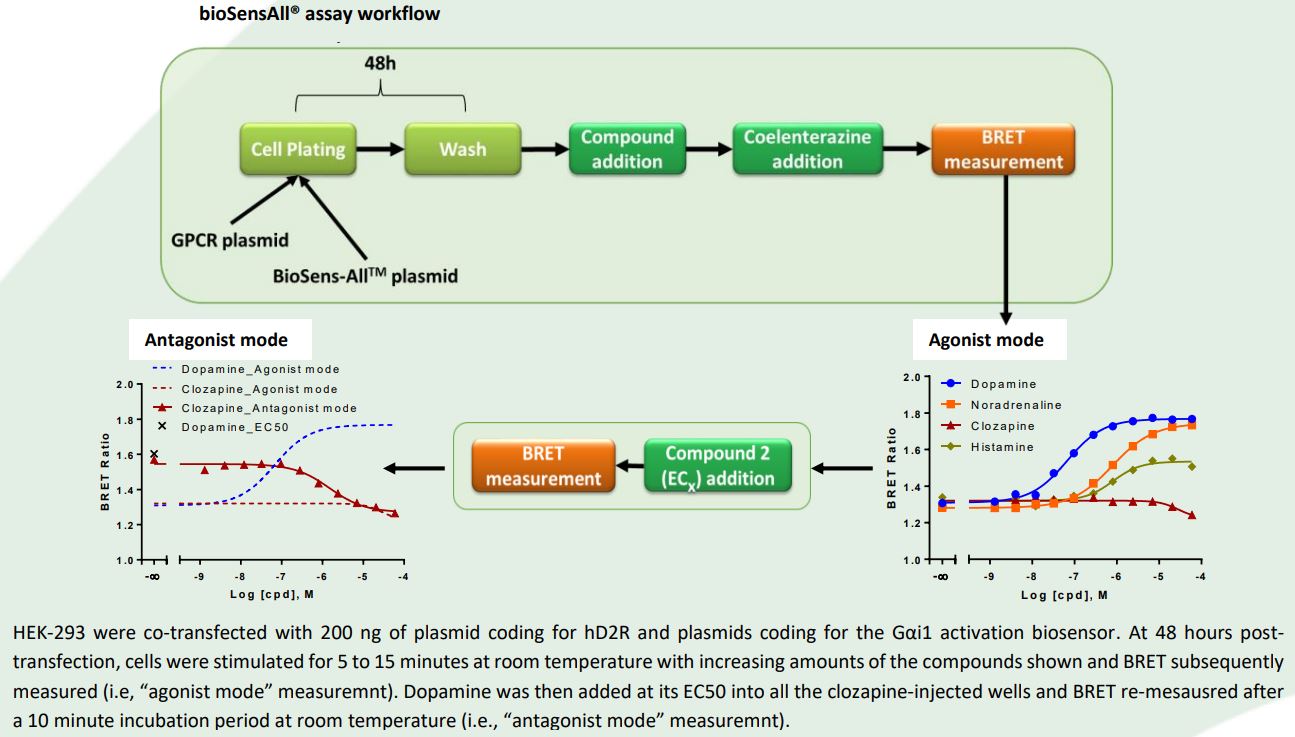Characterization of receptor agonists and antagonists using bioSensAll®
Receptor-targeting molecules are usually classified based on their overt biological activity and binding site. An agonist is a molecule that directly produces a biological response upon binding the orthosteric (i.e., “active”) site on its target receptor. Agonists can be sub-categorized as full, partial or inverse based
on their relative efficacies (vs. the endogenous agonist) in stimulating a biological response. Conversely, an antagonist is a compound that lacks inherent biological activity but interferes with the actions of an agonist upon binding its target receptor’s orthosteric site. Antagonists can also display full or partial
efficacy [2]. Compound classification influences therapeutic indication and provides a mode of therapeutic action. Misclassification and mischaracterization can therefore have significant repercussions. Importantly, compound classification (especially for G-protein coupled receptors) is becoming increasingly complex due to the observation that different ligands can engage different downstream effector pathways and that a given ligand can display different (sometimes reversed) pathway-specific efficacies (i.e., pluridimensional efficacy/biased agonism) [3]. With these emerging paradigms
comes the need for novel sensitive technologies capable of assessing compound efficacies across numerous pathways. In this application note, we show how, in a single experiment via single-well multiple compound addition, the bioSensAll® Gɑi1 activation biosensor was used to characterize human
dopamine D2 receptor (hD2R) agonists and an antagonist. This procedure can be performed for multiple effector pathways in parallel with bioSensAll® biosensors.

Results and Conclusion
The hD2R endogenous agonist dopamine dose-dependently increased activation of the Gαi1 biosensor. Further, noradrenaline and histamine displayed different efficacies in engaging hD2R-downstream Gαi1. Relative to dopamine, noradrenaline behaved as a less potent full agonist and histamine behaved as a less potent partial agonist of the Gαi1 pathway. Clozapine reveled no agonist or inverse agonist activity on Gαi1. However, antagonist mode testing demonstrated that clozapine blocked the cellular response produced by dopamine, thus confirming its established function as a hD2R antagonist. bioSensAll® technology allows for the characterization of full and partial agonists, inverse agonists and antagonists in a rapid, simple and single assay.
References
[1] Mancini, A., Frauli, M., Breton, B. (2015) Exploring the Technology Landscape of 7TMR Drug Signaling Profiling. Curr. Top. Med. Chem. 15(24):2528-42.
[2] Kenakin, T., Williams, M. (2014) Defining and characterizing drug/compound function. Biochemical Pharmacollogy. 87(1):40-63.
[3] Kenakin, T. (2011) Functional selectivity and biased receptor signaling. J Pharmacol Exp Ther. 336(2):296-302.